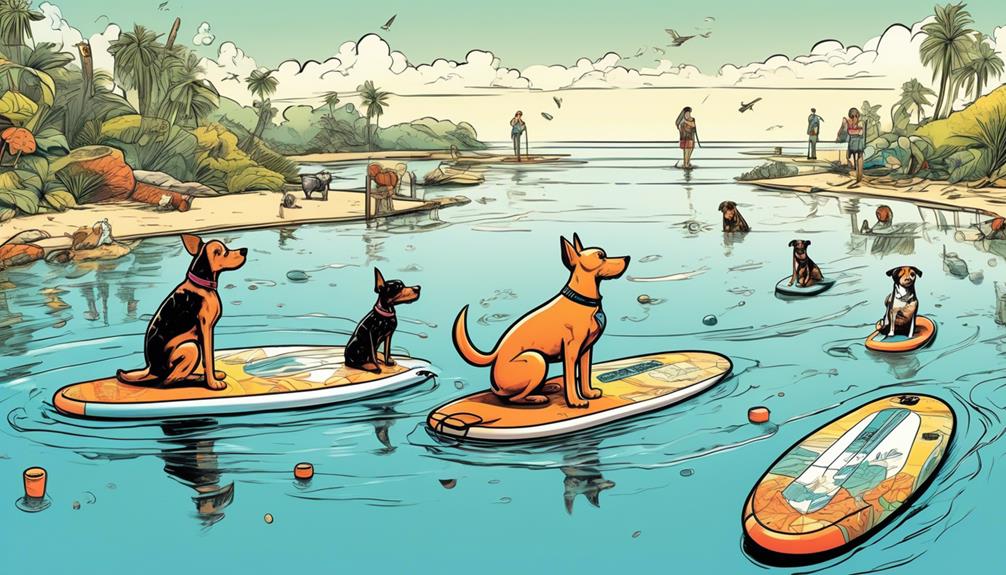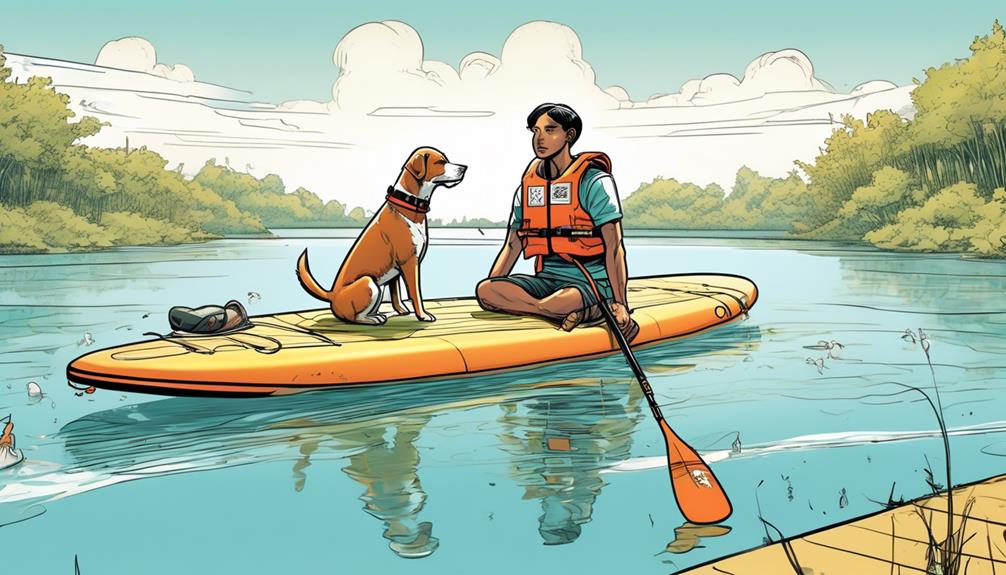So, you're wondering if your dog can hang ten on an inflatable paddle board with you? Let's get real for a sec.
I've been there, board under my feet, and thought, 'What if my furry buddy could join?' It's not just a fun idea; it's totally doable with some prep.
Now, before you picture your pooch surfing the waves, let's talk data. Studies show that with the right safety gear and a suitable board, dogs can not only enjoy paddle boarding but thrive on it. I've seen dogs of all sizes nail this, from Chihuahuas to Labradors. It's all about choosing a board with enough stability and space. Plus, training your dog gradually is key.
I'll break it down for you, sharing personal insights and real-world examples, making sure you get the full scoop on how to make paddle boarding a blast for you and your pup.
So, if you're up for an adventure that's both exciting and bonding, you're in the right place.
Key Takeaways
- Choosing a suitable board with stability, space, width, length, and weight capacity is essential for paddle boarding with a dog.
- Preparing your dog through positive reinforcement, gradual exposure to water, and familiarizing them with the paddle board is important for their comfort and safety.
- Safety measures such as wearing life jackets, using a board leash, checking gear for damage, staying hydrated, and being aware of equipment failure are necessary when paddle boarding with a dog.
- Training and practice, starting with basic commands on dry land and gradually introducing the dog to paddle boarding, will improve their skills and confidence on the board.
Assessing Board Suitability

Before you and your furry friend take to the waters, let's talk about picking the right paddle board. Trust me, I've been there, sifting through options, and what I've learned is that it's not just about whether the board floats with both of you on it. We're talking stability, maneuverability, and above all, safety.
I've dug into the specs – weight capacity, length, and width – and these aren't just arbitrary numbers. They're the difference between a joyful ride and a potential wipeout. Here's the deal: wider boards mean better stability, crucial when your dog decides it's time to play captain and starts moving around. As for length, a medium-sized board strikes the perfect balance, offering enough control without cramping your dog's style.
And let's talk grip. You need a board where your dog won't end up sliding around every time a wave hits. It took some trial and error, but finding a board with a solid grip was a game-changer for us. Our paddle adventures have been epic since.
Data-driven insight: Boards with a width of 32 inches or more provide that extra stability needed. Length-wise, something between 10 to 12 feet offers great maneuverability while ensuring there's ample space for your pup. And, don't overlook weight capacity. For instance, if you're weighing in at 180lbs and your dog at 60lbs, aim for a board that supports at least 250lbs to account for additional gear or any unexpected guests (like that friend who swears they won't get on but always does).
Real-world example: After switching to a 10'6” long, 34” wide board with a 300lb capacity, the difference was night and day. No more unexpected swims for us, and my dog could finally relax and enjoy the view.
Preparing Your Dog
Getting your dog ready for paddle boarding isn't just throwing a life vest on them and hoping they'll magically love the water. It's a process, and if you're like me, you want to ensure they're not just prepared but excited about the adventure.
First things first, let's talk water comfort. Not all dogs are born swimmers. In fact, a study published in the Journal of Veterinary Behavior found that positive reinforcement can significantly increase a dog's comfort with water. So, how do you apply this? Start with shallow water and lots of treats and praise. It's not an overnight process. For my dog, it took about two weeks of short, daily sessions before he started to wade in without hesitation. Patience is your best friend here.
Now, onto the paddle board itself. This is where things get interesting. A 2021 survey by the American Pet Products Association showed that introducing pets to new equipment through play significantly increases their comfort and familiarity. So, I took that advice to heart. I started with the paddle board on dry land, letting my dog explore it at his own pace. I placed his favorite treats on the board to make it even more enticing. The transformation was remarkable. What was once an intimidating, unfamiliar object became a platform of fun in less than a week.
But why does all this matter? Well, if you're planning to hit the waters with your furry friend, you want to ensure it's a safe and enjoyable experience for both of you. Reports from the Coast Guard stress the importance of acclimating pets to both water and water equipment to prevent accidents.
So, you see, it's not just about making sure your dog can handle a paddle board; it's about building their confidence and trust in the water. It's about turning a potential stressor into a source of fun. If you're skeptical about whether your dog can enjoy paddle boarding as much as you do, let me tell you, with the right approach, they absolutely can. And the benefits? Priceless. More bonding time with your pet, improved confidence for your dog, and the pure joy of sharing an adventure together.
Safety Measures

So, you're thinking about taking your dog paddle boarding, right? I get it, the idea seems cool and all, but before we jump in, let's talk safety—because, trust me, it's not just about having a chill day out on the water.
I'm going to lay it out for you with some real talk and data-driven insights that'll make you rethink how you prep for a day with your pup on a paddle board.
First things first, life jackets are non-negotiable. I know, I know, you're probably thinking you and your dog are excellent swimmers. But here's the deal: according to the American Canoe Association, most drowning incidents with paddle boarders occur due to the absence of a life jacket. So, when I say my dog and I never hit the water without our life jackets strapped on, I'm not playing around. It's about being smart, not scared.
Next up, let's talk about the leash—and no, not the kind you're thinking. I'm talking about a board leash for your dog. Picture this: you're out there, in the middle of a lake, and something catches your dog's eye. Without a second thought, they're off the board chasing after who-knows-what. With a leash, though, you're ensuring they stay attached to the board, making it easy to reel them back in if they decide to go rogue. It's about safety, not restriction.
Checking your gear is where it gets real. Did you know that most paddle board accidents related to equipment failure are due to neglected maintenance? Before I even think about getting on the water, I give my board a thorough once-over for any signs of damage or wear. It's a simple step, but it could mean the difference between a great day out and a call to the coast guard.
Lastly, let's talk hydration. It sounds so simple, yet it's easily overlooked. You'd be surprised at how many people forget to bring enough water for themselves, let alone their furry friend. The sun's beating down, you're working those muscles—dehydration can sneak up on you. I always pack a dedicated water bottle for my dog, alongside my own. Because, according to a study by the Veterinary Medical Association, even mild dehydration can severely impact a dog's health and performance.
Training and Practice
Training and practice with your dog for paddle boarding isn't just a good idea; it's essential for a successful and enjoyable time on the water. Imagine trying to surf without ever touching a board – it's bound to end in a splashy disaster.
Let's break it down with some real-life examples and data-driven insights so you know I'm not just making this up.
Starting with simple commands on dry land was my first move. Commands like “sit,” “stay,” and “no” weren't just about obedience; they were about building a foundation of trust. This part is critical. According to a study published in the Journal of Veterinary Behavior, consistent command training enhances dogs' ability to follow directions, especially in distracting environments. My dog needed to know I'd his back, and I needed to trust he'd listen – a two-way street that's vital for any successful team.
When we transitioned to water, we stuck to calm, shallow areas initially. Our first few attempts were, frankly, a bit of a comedy of errors. But here's where patience really paid off. A study from the International Journal of Environmental Research and Public Health suggests that gradual exposure to water significantly reduces stress in dogs, making them more adaptable to new activities like paddle boarding. We practiced getting on and off the board, finding our balance, and moving together as a team.
But let's get to the secret sauce here. It wasn't just about the physical training. It was about deepening our bond and understanding. With each session, our confidence grew, transforming what once seemed daunting into second nature.
It all boils down to commitment, patience, and a sense of adventure. The payoff? Absolutely priceless. Studies show that engaging in activities with your pet strengthens your bond, reduces stress for both of you, and can even improve your physical health.

